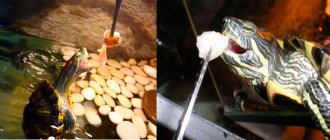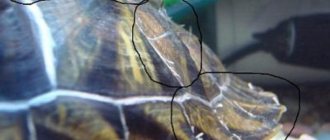For reptiles to feel good, their living conditions should be as close to natural as possible. This applies to the design of the terrarium or aquarium, lighting and heating. An ultraviolet lamp for turtles is necessary for the normal functioning of reptiles.
These lighting devices improve the vision of reptiles, making it colorful and clear. In addition, under the influence of ultraviolet radiation, metabolic processes are accelerated, and the immunity of reptiles is increased.
In the absence of a UV lamp, the condition of turtles gradually worsens, some diseases develop, and the risk of death of a pet increases. To avoid this, you need to correctly select, install, and use the device.
Effect of ultraviolet radiation on turtles
UV lamps for reptiles differ in wavelength, which affects them differently:
- UVA - long rays.
- UVB – medium waves.
- UVC is a short wave C.
This is interesting! Waves of type A and B are necessary for a full life, they are in the range of 400 - 315 nm, and also 315 - 280 nm. The proportion of radiation in lamps is strictly dosed; as a rule, the wavelength does not exceed 290 - 294 nm. This is a suitable spectrum for reptiles, from which you should not deviate. For example, an indicator up to 290 nm (short C waves) is already considered harmful to health, and more than 310 nm destroys vitamin D3, which is synthesized only with a certain combination of waves.
Type A waves have a beneficial effect on the vision of reptiles. In this range, the surrounding space becomes clearer and objects are better perceived. Then the inhabitants of the terrarium become more active and make contact better.
Zone B waves stimulate the production of vitamin D3, which maintains calcium levels in the reptile's body.
For the complete formation of vitamin D3 in the skin of amphibians, UV radiation is supplemented with infrared or thermal radiation.
Exposure to ultraviolet rays accelerates the absorption of calcium from food. Then the bones of adult reptiles become stronger, and their growth accelerates in young reptiles.
Glow time
How long should both reptile lamps burn? Both normal and ultraviolet light should be on for the entire daylight hour of 10 to 12 hours. They don't travel at night.
To automate this process, it is recommended to purchase a timer socket or timer.
Manually set their start time (8:00) and stop time (20:00). Automation will do the rest for you.
In the morning you can sleep a little more, and in the evening you can not be distracted from watching your favorite TV series.
Why is an ultraviolet lamp needed in a terrarium?
A UV lamp for turtles is a necessary device for the full life of amphibians. In their natural environment, they receive ultraviolet radiation from the sun. When their habitat changes, reptiles suffer from a lack of light, which leads to disease. This is especially dangerous for pregnant females and young individuals.
A UV lamp for reptiles is an excellent substitute for sunlight and promotes the absorption of calcium from food or vitamin supplements. Without this lighting device, the beneficial substance is not absorbed in the body, then the density of bone tissue decreases and its growth slows down.
Important! With a lack of calcium, the amphibian's shell softens and deforms. Then the turtle may develop rickets, which in most cases leads to death. Bone fragility increases, and cases of limb fractures become more frequent.
For the red-eared turtle, which is part of the group of aquatic reptiles, an ultraviolet lamp is not so important, although it is desirable. This is due to the fact that they are predators, and vitamin D3 levels increase by feeding on small aquatic animals. For land turtles, UV radiation is much more important than for red-eared turtles, since the former do not receive D3 from food at all.
Thus, the ultraviolet lamp prolongs the life of the inhabitants of the terrarium.
How much can you use
Typically, the packaging of ultraviolet lamps indicates a service life of 1 year. However, the service life is often influenced by several factors: the conditions and needs of the reptile. It is recommended to change the lamp every year if we are talking about a quality lamp. A cheaper light source should be changed every 4 months.
The expiration date of the product is indicated on the packaging
Important! You should not buy cheap UV lamps, as they practically do not produce ultraviolet light, which is necessary for turtles. It is necessary to change the lamp due to the fact that after regular use the radiation intensity is reduced by half
You shouldn’t take risks, because reptiles have a very slow metabolism, so it’s difficult to immediately notice that radiation is useless or harmful to your pet’s health. It is best to give preference to expensive lighting sources from trusted brands
It is necessary to change the lamp due to the fact that after regular use the radiation intensity is reduced by half. You shouldn’t take risks, because reptiles have a very slow metabolism, so it’s difficult to immediately notice that radiation is useless or harmful to your pet’s health. It is best to give preference to expensive lighting sources from trusted brands.
Note! In a light bulb that is no longer usable, yellowed spots appear at the junction of the bulb, which in appearance resemble scale. Dark spots often appear inside the bulb, which indicate that the lamp should be replaced
The UV lamp can be replaced with erythema lamps, which are used for tanning
Such lamps have a harsher light, so they can only be turned on for 5-10 minutes. It is important to consider that the light of such a device can negatively affect the health of the pet. Such light sources are harmful to the reptile's vision.
It is impossible to make a UV lamp yourself due to the impressive list of requirements. The correct parameters determine the health of the reptile, so you should not take risks.
Lighting plays a major role in the life of a turtle. For a pet’s comfortable life at home, an ultraviolet lamp is suitable, the radiation of which is responsible for the proper functioning of the reptile’s body. Such lamps must be changed at least once a year and preference should be given to products from trusted brands.
How to choose the right one
Not all novice breeders know what kind of lamp is needed for turtles. As mentioned earlier, two types of lighting elements are used for the terrarium: incandescent and ultraviolet.
Some reptile owners install 2 tungsten filament bulbs in their aquarium. They explain their choice by the fact that such devices are cheap and do a great job of warming up turtles. However, reptiles need not only warmth, but also ultraviolet light. With a lack of UV radiation, they gradually wither and begin to hurt.
Service life
Each package of ultraviolet light bulbs contains information about the service life. If you use it correctly, a high-quality product will fully work for the specified time. If the period has already expired and the lamp is still working, then do not forget that it is no longer so effective, since the fluorescent burns out during the warranty period.
This lamp is suitable for regular lighting for plants and aquariums.
How to properly install a UV lamp
During the cold season, ultraviolet and heating lamps should be installed above the turtle in the terrarium. The distance from the lamps to the pet’s shell starts from 30 – 35 cm. If the gap is smaller, then there is a risk of burns and damage to the cornea.
Heating lamps must maintain a temperature of 28 to 30° so that turtles lead an active life and their bodies work smoothly. As a rule, the device runs all day and is turned off at night to reduce the temperature to 18 - 25°.
For an aquatic turtle, the aquarium is divided into 2 zones: warm and cold. Heating lamps are installed above the “sushi island” where the pet will rest. The maximum temperature for the warmest area is 40°. In order for the turtle to cool down, it will need to go into cool water.
There should be enough water in the aquarium so that a turtle that turns over on its back returns to the opposite position on its own.
The light bulbs must be mounted so that the entire area of the terrarium is evenly illuminated and there are no “blind spots”.
There are tubular (length from 30 to 120 cm) and compact light bulbs on the lighting market; the method of installing them differs. For the former, you need to install a suitable lampshade or grooves into the aquarium lid, and then install the light source itself, and for the latter, a regular threaded base (E27) is suitable. Tubular devices are suitable for larger terrariums, while compact ones are suitable for small boxes.
Important! When installing an ultraviolet lamp for a turtle, you need to consider its safety. The device must be securely fixed so that the reptile does not loosen it. It is also necessary to check the condition of the wiring; if the contacts are loose or exposed, then correct the situation, as there is a risk of electric shock to the pet.
A few words about accommodation
The incandescent lamp for turtles should be located in the aquarium in such a way that there are several thermal zones inside it. The turtle will choose the optimal place for itself. In addition to the heating lamp for turtles, there must be an ultraviolet lamp in the terrarium, which promotes the production of vitamin D3 in reptiles. It should be noted that a UV lamp should only be used with heating elements, since vitamin D3 is absorbed only in warmed reptiles.
Lighting should be done exclusively from above the aquarium, so as not to irritate the sensitive cornea of the reptile's eyes. The temperature should be measured directly under the heating element, but not at the level of the aquarium floor, but at the level of the turtle's shell, since at the level of the shell the temperature will be slightly higher
Do not allow the temperature to rise above + 32 degrees. Please note that the heating zone must be no less than the length of your pet; do not allow moments when the turtle is not able to completely fit under the light bulb. In this case, you should hang the lighting element a little higher and increase its power. Stick to daylight hours
Turn the lighting fixture on and off at the same time so as not to disrupt the reptile's life rhythms. In summer, when the terrarium is well lit and heated, it is permissible not to use a heating element, while a UV lamp is a must for your pet.
Remember! Not only its comfort, but also its life depends on the correct arrangement of all elements in a turtle’s terrarium. Try to make the life of a turtle in captivity as comfortable as possible and it will delight you throughout its long life.
Is it possible to do without ultraviolet light?
Some breeders are replacing ultraviolet lamps with filament devices. However, incandescent light bulbs serve only for heating; the dose of UV rays they emit is negligible.
Other turtle owners believe that natural light is enough for them to live a full life. However, the windows and walls of the terrarium do not transmit useful radiation. Some breeders take their pets out into the sun to get a dose of nutrients. This can only be done in the warm season, as turtles are sensitive to drafts and low temperatures.
Important! If the turtle does not receive UV light for 2 weeks, its health will suffer. This is especially true for land species.
It is strictly contraindicated to use the following types of lamps for turtles:
- Medical.
- To check banknotes.
- Phytolamps.
- For fish.
- For a manicure.
These devices cannot replace an ultraviolet lamp for turtles, which emits waves of a certain spectrum and in a strict dosage.
There are lamps that emit UV rays in a certain range and heat the terrarium. However, such devices are difficult to find.
Content Features
The red-eared turtle is quite demanding in terms of living conditions. When purchasing such a pet, you need to understand that the size of the aquarium does not have any effect on the size of the reptile. Even in a small container the animal will grow, but will become weak and sick.
To provide your reptile with comfortable living conditions, you must purchase the following:
- aquarium for turtles with a volume of 150 l;
- 100 Watt water heater;
- external filter;
- ultraviolet lamp for aquatic turtles with UVB 10%;
- heating lamp;
- lighting lamp;
- thermometer;
- sushi element.
The aquarium consists of a number of elements
Main conclusions
Ultraviolet lamps for turtles are the most important element of the lighting system. There is no worthy alternative to this device, since useful radiation has a beneficial effect on the functioning of the entire reptile body. Now you know which UV lamp to choose, it is important to pay attention to its power, wavelength, spectrum, age and general condition of the pet.
The duration of exposure to ultraviolet radiation for young animals is from 4 hours, for adults – from 2 hours. If necessary, the lamp can be left on for 10 - 12 hours. Devices should be replaced approximately a month before the expiration date, as their beneficial effect is reduced, which threatens the deterioration of the pet’s well-being.
Previous
Lamps and fixtures Table of the power ratio of LED, energy-saving and incandescent lamps
Next
Lamps and lampsHow to choose a lamp for flowers and indoor plants
Lamp with or without reflector?
When choosing lamps, it is also important which lamp you screw into. The fact is that such UV lamps do not have a reflector and scatter light in all directions.
Therefore, lamps with reflectors are most effective.
They have a shielded surface in the dome that concentrates the rays and directs them in a specific direction. Here is a clear example of two different lamps with the same bulbs and the UVB levels they measured.
The efficiency of a model without a reflector is half as effective!
Therefore, think carefully before installing UV bulbs in the body of a regular table lamp.
Do you want to lose so much useful radiation?
1. "Arcadia"
Arcadia Reptile lamps are designed taking into account the scientific recommendations of zoologists. UV radiation levels are as close as possible to the lighting found in the wild where turtles live. Also, for different types, the appropriate level of radiation required is provided.
The range is represented by the following models:
| Name | UVB | Form | Purpose (for what types of turtles) | Height to lamp | Lifetime |
| D3 Basking Lamp 80W, 100W, 160W | UV + heating | E27 | For large land species | Not less than 30 cm | 1-3 years |
| D3+ Dragon Lamp | 14% | T5 | For land | 35-40 cm | 1 year |
| D3+ Desert Lamp | 12% | T5, T8 | For land | No more than 50 cm | 1 year |
| D3 Forest Lamp | 6% | T5, T8 | For water | No more than 15 cm for T8, For T5 – 25-30 cm | 1 year |
Important! Note! The “ Reptile Compact Lamp ” and “ Desert Compact Lamp ” models, E27 forms, have been discontinued.
- Arcadia lamps are very popular.
"Lucky Reptile"
One of the leading European companies, with its head office in Waldkirch, in Baden-Württemberg (Germany).
Various devices for caring for reptiles have been created based on many years of research by leading European scientists. In particular, many modern lamp models combine three necessary characteristics:
- Warm,
- Light,
- Ultraviolet radiation.
All parameters are selected in optimal proportions for turtles of different species and ages.
The indicators are as close as possible to natural sunlight.
| Name | UVB | Form | Purpose (for what types of turtles) | Height to lamp | Lifetime |
| UV Sun | 6% | T5 | For water | No more than 30 cm | 1 year |
| Bright Sun UV Jungle | UV + heating | T27 | For water | Not less than 30 cm | 1 year |
| Bright Sun ULTRA Desert | UV + heating | T27 | For land | Not less than 30 cm | 1 year |
| Bright Sun FLOOD Desert | UV + heating | T27 | For land | Not less than 30cm | 1 year |
| Bright Sun UV Desert | UV + heating | T27 | For land | Not less than 30cm | 1 year |
The listed models of the “Lucky Reptile” brand have an undeniable advantage - they are suitable for table lamps with the most common base.
Lighting
The terrarium must have a small island of land on which it will bask and rest. It is advisable to install an incandescent lamp above it. The distance from it to land should be such that it heats the air to a normal level of 28-30 °C.
Lighting for a terrarium or aquarium is mandatory. Turtles need about 8-12 hours of daylight for an active life. Its duration depends on the time of year. For lighting, fluorescent lamps with a power of 15-40 W are used. It is necessary to provide in advance the length of the lighting fixture. In this case, the dimensions of its lampshade must correspond to the length of the wall of the aquaterrarium.
Rickets of the red-eared turtle
This disease is encountered by most turtle breeders who do not immediately install UV lamps in the aquariums of still young turtles.
The symptoms of this disease are:
- drowsiness;
- tumors;
- softening of the shell and skeletal bones;
- convulsions;
- deformation of the lower jaw;
- refusal of food;
- swollen and closed eyes;
- general weakness.
If signs of this disease appear, you should contact your veterinarian for help. You also need to diversify your pet’s diet, include special additives and mineral supplements, if possible, increase the amount of meat, sea reptiles and shellfish (their shells contain calcium), and foods containing vitamin D.
In advanced cases of rickets, turtles are prescribed injections of drugs that contain calcium; they must also be left under a quartz lamp once a day for 15 minutes, the distance to which should not exceed or be less than 20 - 25 cm.
Intensive treatment must be carried out for one and a half months, and after half a year, under favorable circumstances, the disease may completely recede.
To prevent the disease, it is enough to follow a varied diet, keep the turtle in a spacious terrarium and irradiate it with ultraviolet light daily (especially in winter).
5. "ExoTerra"
The famous American company, specializing in the production of specialized products for the care of pet reptiles, has its representative offices in many countries around the world. The range of lamps offered by the manufacturer can be considered the richest.
| Name | UVB | Form | Purpose (for what types of turtles) | Height to lamp |
| Repti Glo 5.0 | 5% | T8 | For water | No more than 15 cm |
| Repti Glo 10.0 | 10% | T8 | For land | No more than 30 cm |
| Sunray | UV + heating | E27 | For large land ships | Not less than 30 cm |
| SolarGlo | UV + heating | E27 | For large land ships | Not less than 30cm |
| Turtle UVB Bulb | 5% | E27 | For water | No more than 15 cm |
| Reptile UVB100 | 5% | E27 | For water | No more than 15 cm |
| Reptile UVB100 Linear bulb | 5% | T8 | For water | No more than 15 cm |
| Reptile UVB150 | 10% | E27 | For water and land | No more than 15 cm |
| Reptile UVB150 Linear bulb | 10% | T8 | For water and land | No more than 15 cm |
| Reptile UVB200 | 12% | E27 | For land | No more than 30 cm |
| Reptile UVB200 Linear bulb | 12% | T8 | For land | No more than 30 cm |
ExoTerra has a wide selection of models.
Possible replacements and what should not be used
In addition to UV emitters, you can use erythema tanning lamps, for example, “Photon”. However, this is quite risky, since these devices emit harsher ultraviolet radiation, and therefore their use must be minimized. To avoid burns to the skin and corneas of the eyes, it is recommended to hold such a lamp over the terrarium for no more than 5 minutes a day.
Often people try to find alternative sources of UV radiation. At the same time, many are looking for a replacement based on the color of the emitted light, believing that blue light is a clear sign of the presence of ultraviolet radiation. Definitely not suitable for breeding turtles:
- energy saving with cold light;
- quartz lamps;
- luminescent;
- intended for fish and plants;
- medical;
- installed in devices for checking money;
- manicure
It is best not to waste time and money, but to immediately purchase the right lamp in a specialized retail or online store. This will protect your pet's health.











